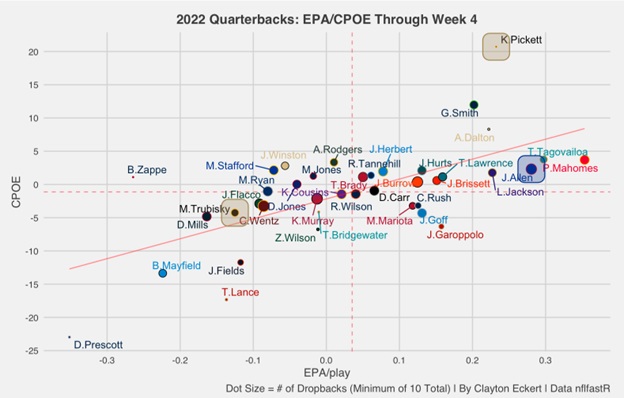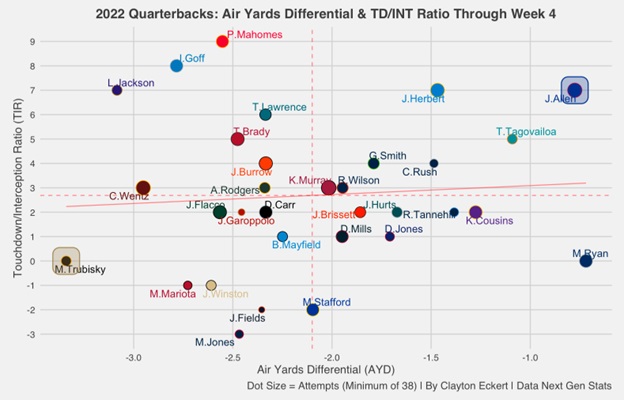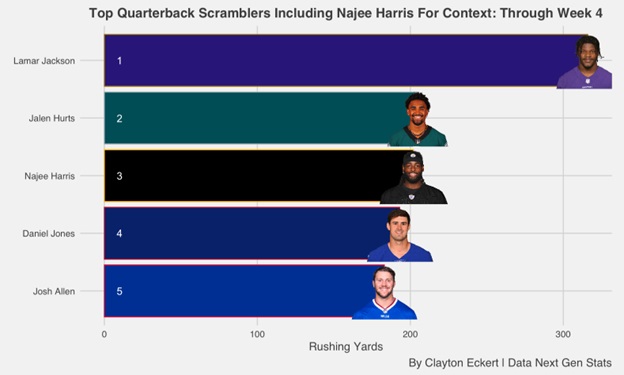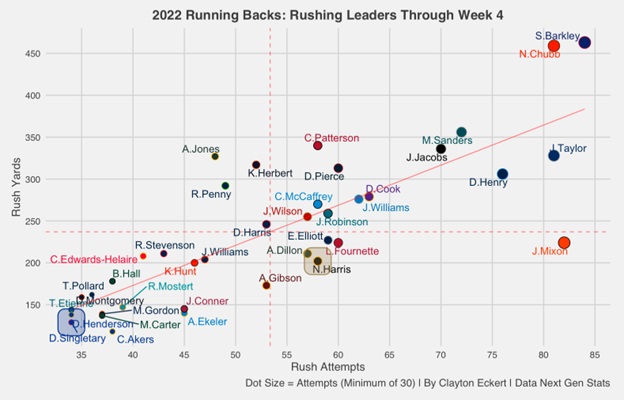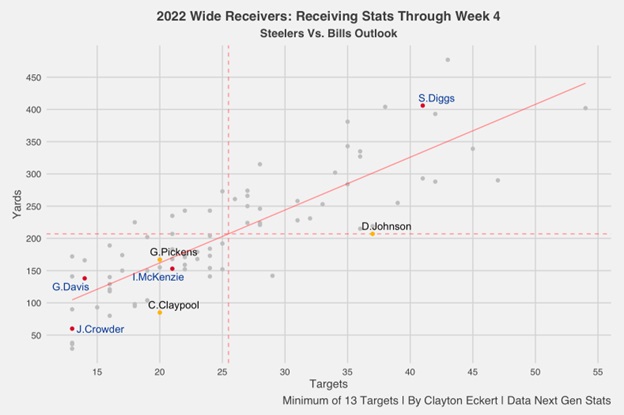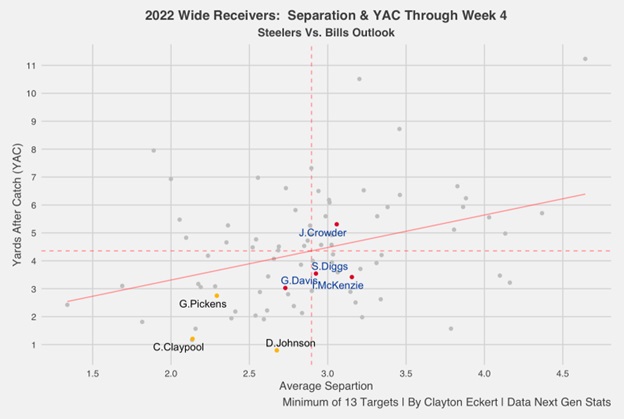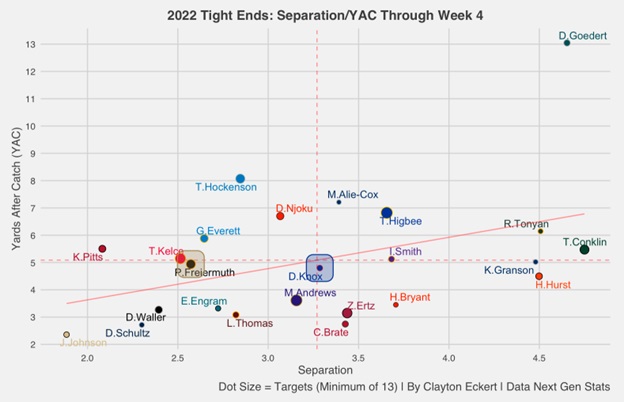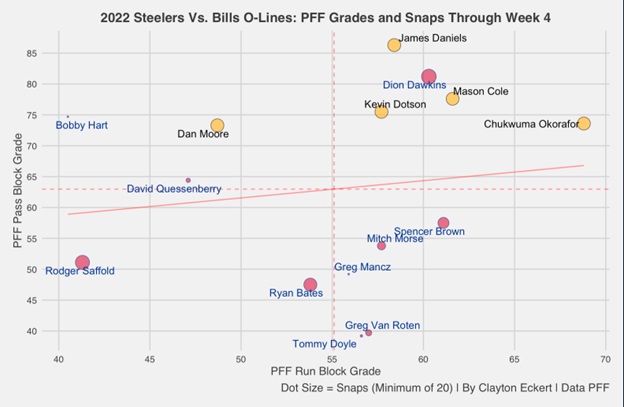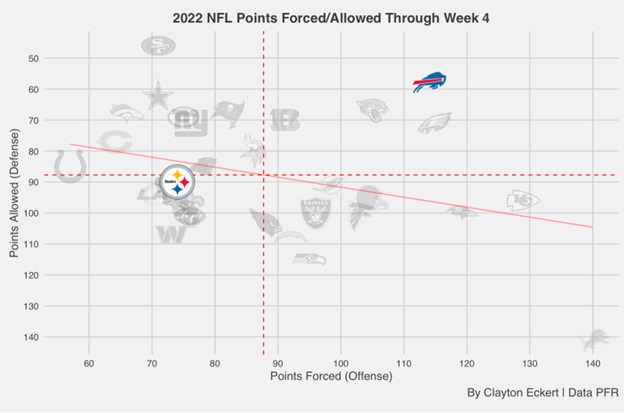The 1-3 Pittsburgh Steelers have a tough challenge on Sunday, traveling to Buffalo to take on one of the best teams in the league in the Bills. Pittsburgh was able to come out victorious in the last matchup to open the 2021 season, where the Steelers defense held quarterback Josh Allen and their potent offense to only 16 points, and Pittsburgh putting all 23 of their points on the board in the second half, including a punt block for a touchdown on special teams. A similar formula will likely need to take place once again in hopes of victory, with all three phases of the game needing to pull their weight against this well-rounded team.
Let’s start with the quarterback position. Allen is the prototype quarterback, able to get it done through the air with the second most passing yards on the season (1227) on the third most attempts (168), as well as on the ground.
To highlight this, I wanted to provide context on the quarterbacks dropbacks (pass attempts, scrambles, or sacks), using expected points added (EPA = expected points after a play – expected points before the play) and completion percentage over expected (CPOE = probability for a complete pass compared to similar situations), valuable metrics for the position:
Starting with Allen, we can see he has the third ranked EPA through four games along with an above the mean CPOE that ranks eighth out of the 39 quarterbacks on the graph. Using EPA per dropback, we also get the extreme value that mobile quarterbacks add to their team. The stellar play of Pittsburgh’s defensive line was a big key to the win against Allen and the Bills last year, an extremely tall task without edge rusher T.J. Watt, who had a team high two sacks in the 2021 affair. Defensive lineman Cameron Heyward wreaked havoc in the 2021 matchup, with a whopping 12 pressures and a sack, and hoping he can step up again, to hopefully make life easier on the banged up secondary (Ahkello Witherspoon ruled out, along with safety Terrell Edmunds and Cameron Sutton being questionable), and to make Allen less comfortable.
Pittsburgh is moving to rookie quarterback Kenny Pickett, who had the top ranked CPOE in his second half performance last week against the Jets. While he only had 17 dropbacks (fewest on the graph), he also provided great value with his fourth ranked EPA, including two rushing scores in his debut. Hopefully this is a wrinkle he can continue to provide in his first start of the regular season, especially in short yardage and goal line situations.
We also can see from the visual Steelers quarterback Mitch Trubisky and additional context to his benching, especially with the 34th ranked EPA in 3.5 games along with a 31st rank in CPOE. The offense has struggled mightily to sustain drives and put points on the board, and the numbers really give context in comparison to the league. Another main aspect that brought his EPA down was sacks, taking untimely and unnecessary ones with eight total on the year. Ironically, Allen has also been sacked eight times, and it would be huge if Pittsburgh’s defense can get at least a couple in the game.
Next let’s look at quarterbacks air yards with intended and completed air yards:
This visual likely surprises some in multiple regards, starting with Allen’s low 6.9 intended air yards that ranks 25th out of 32 quarterbacks on the graph given his reputation for slinging it, along with a 6.1 completed air yards number that ranks 15th. Trubisky threw deep at one of the highest rates in recent weeks, increasing his IAY to 9.9 which ranks fourth through four weeks but only a 6.5 CAY that ranks seventh. This is a big point that came up in my week four passing locations article, and hopefully we see an improved air yards differential with Pickett moving forward, which I will provide now as we continue to gain context, along with touchdown/interception ratios through the season thus far:
Here we can see the stark difference in the teams passing results so far this season, with Allen having the second ranked air yards differential in the NFL. While he has a much lower IAY, he has been connecting at a high 67.3% completion percentage on his attempts (6th), along with providing one of the strongest TIR in the league, tied for the second most touchdowns (10) and has three interceptions. In comparison, Trubisky by far had the lowest AYD of -3.3 in the NFL through four weeks, along with two touchdowns and interceptions. It will be very interesting to see how Pickett fares in this aspect of the game (coming off a zero TD, three interception game), and if Pittsburgh’s defense can provide a takeaway (or optimistically more, paging safety Minkah Fitzpatrick) against Allen, who has been strong in this facet of the game.
Speaking of Allen’s strengths, let’s look at quarterback scrambling leaders for the season, including running back Najee Harris to give context to their rushing yardage:
As usual, Ravens quarterback Lamar Jackson dominates in this regard. Allen has the fourth most rushing yards (183) at the quarterback position, a very impressive number considering he is close to Harris’ 202 rushing yards which ranks 28th out of all NFL rushers through week four.
How do you think the Steelers defense will fare against Allen? What about Pickett in the first start of his career?
Segueing to the running backs, let’s start with a simple view of the rushing leaders at the position:
Harris leads the outlook in attempts with 58 and above the NFL mean (T-14th), but average with the 25th rank in yardage on a low 3.5 yards per attempt. He leads the matchup with 10 forced missed tackles, and hopefully he can provide more of that against the Bills defense that is ranked third in rushing yards allowed. Harris is also the only running back in the matchup with a touchdown to date, and interestingly all running backs for each team have one fumble on the season. Here’s to hoping Pittsburgh can get a takeaway in this regard.
Bills running back Devin Singletary leads the team with 34 rushing attempts for 129 yards, at 3.8 yards per attempt. Buffalo’s backups have also provided value in their opportunities. Zach Moss leads the outlook with the longest run, a double explosive of 43 yards this season, getting outside of the defense down the sideline. James Cook also has a 33-yard run, a toss getting outside behind good blocking. This brings up a big key for Pittsburgh’s defense in my opinion, playing gap sound and especially containing the edge to hopefully limit explosive rushes along with Allen’s scrambling prowess.
Singletary leads the matchup in the receiving game with 19 targets and 141 yards, providing more value here than on the ground. Harris did not have a reception last week, and here’s to hoping he can be a factor this week, adding to his 11 targets, 10 receptions, and 48 yards on the season. Moss and Cook each have seven targets for the Bills, with the former having a perfect catch percentage and the latter having more yardage (37).
Now let’s look at the lead backs and how often they’ve seen eight men in the box (8MIB%), along with NextGenStats efficiency metric (EFF = total distance a player traveled on rushing plays as a ball carrier. The lower the number, the more of a north/south runner):
Here we see Harris and Singletary have seen stacked boxes at a similar rate, with the latter having a 20.6 8MIB% that ranks 16th, while Harris has seen them at 19% which ranks 18th. It will be interesting to see what this looks like in the matchup, and if Pittsburgh’s defense commits to the passing game as expected, could open up opportunities for the Bills on the ground if they so choose. The efficiency numbers highlight Singletary’s more straight-ahead running style, with the 20th rank in this regard. In comparison, Harris has the seventh lowest 4.33 EFF number, highlighting him running more sideline to sideline. Hopefully the Pittsburgh o-line can create holes for him to read and hit quickly up field. Keeping the scoreboard close early would be huge for Pittsburgh, to hopefully keep their offensive attack balanced as opposed to having to abandon the run against the Bills pass defense the has surrendered the least yards.
How do you think the running games will fare?
Now for the wide receivers, a hugely important position in the matchup. Here are their targets and yards through four weeks:
Bills wide receiver Stephon Diggs is having another strong season, with the second rank in yards (406) and receptions (31) on 41 targets (seventh). He is also tied for the most touchdowns with four, and will be a handful for a banged up Steelers secondary. Diggs had 12 targets and nine receptions in the matchup last season, but the Steelers were able to limit him to only 69 yards, with the pass rush playing well, along with bracketing Diggs and playing zone often to keep everything in front of them. This is one of the biggest keys to the game in my opinion, what will the availability and quality of play be for the Steelers defense? Will they have to blitz more sans Watt or can edge rusher Alex Highsmith have a big game and add to his 5.5 sacks which is currently second in the NFL, or will Diggs be able to have a big game?
Pittsburgh wide receiver Diontae Johnson is tied for 11th in the NFL with 37 targets but right at the mean with 207 yards (T-37th), which is the lowest among players with 30+ targets. He is yet to score a touchdown this season, which is still a crazy feat no Steeler receiver has accomplished in four games. Here’s to hoping this is the week, and particularly looking for Johnson to get his first of 2022 as he did in the last matchup when he scored the only offensive touchdown.
The position room for the Bills is banged up, starting Buffalo wide receiver Isaiah McKenzie who is in the concussion protocol. It will be interesting to see if he plays with his status questionable for Sunday. He has the second most team targets (21), with 153 yards and an impressive three touchdowns, which have all come from the red zone, so hopefully the Steelers defense is ready for that component if he is available. McKenzie has primarily played in the slot, and he and Diggs have moved around the formation the most, which could present a challenge for the secondary.
Steelers wide receiver George Pickens has 20 targets for 167 yards, and had an encouraging week four performance when he led the position room with eight targets, six receptions, with an especially encouraging route variety and connection with Pickett for some impressive throws and contested catches. Here’s to hoping that continues against a solid Bills defense.
Pittsburgh wide receiver Chase Claypool matches Pickens in the target department, but a much lower 85 yards along with no catches last week on three targets, including a missed contested catch downfield off his hands that went for an interception. Really hoping he can turn things around considering his struggles overall (more on that in a bit).
Bills wide receiver Gabe Davis has 14 targets on the season for 138 yards, and has an outlook high 17.3 yards per reception. He has primarily played out wide and has been quiet as of late after a strong season opener with 88 of his yards, an explosive touchdown, and another double explosive catch of 47 yards. He also had the lone receiving touchdown for the Bills in the 2021 matchup, and here’s to hoping the Steelers defense can limit him as well as explosive plays against the Bills who have 15 on the year on offense to date.
Buffalo wide receiver Jamison Crowder has been ruled out for the game on Sunday, and is the teams fourth most target receiver through week four (13) with 60 yards and has primarily played in the slot. He has an average of ten yards per reception, a feat that every Bills wide receiver has accomplished through four games. In comparison, Pickens is the only Pittsburgh wide receiver above ten, with a 15.2 number.
This brings me to my next point, and a major struggle for the Steelers passing game so far. Here are the separation and YAC numbers for NFL wide receivers:
While not elite so far in 2022, the Bills’ receivers all win out in both data points. Crowder is the only wide receiver that’s above the mean in both data points, averaging 3.1 yards of separation (27th), along with 5.3 YAC (24th) so far in 2022 another aspect the Bills will be without in the matchup. McKenzie leads the outlook 3.2 yards of separation (24th) which is impressive considering he has been given the 13th least amount of cushion of the line. If McKenzie is unable to play as well, this could be huge in the Steelers hopes to limit Diggs and the Bills passing game. Diggs is the third player that is above the mean (slightly) in separation, and below the mean with a 3.5 YAC average. Davis is the only Bill below the mean in both, but still above Pittsburgh in both data points.
Pittsburgh’s receivers have struggled mightily in these two areas, especially with YAC. Johnson still has the league’s worst number 0.79, which is the only result below a yard in the NFL, along with Claypool’s third lowest mark of 1.2. Pickens improved in this regard last game, bringing his season average up to 2.75, which is the 18th lowest in the league. In terms of separation, Johnson leads the Steelers at 2.7, Pickens at 2.29, and Claypool with a very low 2.1 number that is the ninth lowest mark in the league. Here’s to hoping they can provide more in this regard, with Pittsburgh hopefully scheming to get the receivers more open considering the above, with the offense and in turn Pickett hopefully able to benefit in his first full game.
Last thing for the receivers, I wanted to provide the percent of teams air yards and catch percentages, which are very telling through week four:
Diggs is the only above the mean player in both data points, accounting for nearly 40% of the Bills air yards which ranks eighth in the NFL. He has provided the third best catch percentage of players with 35+ TAY at an impressive 75.6%, which is also 12th overall, highlighting the stellar connection so far this year. In comparison, Johnson’s has a 31.4% TAY which ranks 22nd, but a much lower 62.2 catch percentage that is just below the NFL mean. Pickens has shown up more after a quiet start to the season, third in the outlook and just above average with 25.9% TAY and improving his low 41.7 catch percentage to 55% following the week four game. Claypool has the same catch percentage of 55 along with 16.1% TAY. It will definitely be interesting to see the distribution on Sunday and moving forward with Pickett.
Davis has the second ranked TAY for the team, but at a much lower 15.3% which highlights how much Allen is leaning on Diggs. Davis did miss one game however, so it will be interesting to see if he is utilized more in the matchup. McKenzie has the third ranked TAY for Buffalo (11.5%) along with a strong 71.4 catch percentage, which is second best in the outlook and tied for 18th in the NFL, the question is if he will play. Crowder has the lowest marks in both data points through week four, with a TAY of 10.6 and a particularly low 46.2 catch percentage, which the fifth and sixth lowest ranks but will be sidelined.
Which wide receiver room will have the better game? Which team will struggle more as a passing offense/defense given all the injuries?
Next up are the tight ends, and here are the receiving stat leaders for the position:
Steelers tight end Pat Frieirmuth is one of 11 tight ends to land on the top right of the graph, with 18 receptions and 223 yards which each rank sixth in the NFL out of the 24 total players on the graph. He also has the only touchdown in the outlook. Freiermuth led the team in week four with nine targets and seven receptions after a quiet week three game, when ran less routes as he helped as a blocker. This could be the case again against stellar edge rusher Von Miller, and it will be interesting to see how this plays out. Bills tight end Dawson Knox was ruled out for the game, dealing with foot/hamstring injuries. He leads the team 12 receptions and 111 yards on the year. Fellow tight end Quintin Morris is the next man up with three targets and catches for 28 yards, and hopefully this allows Pittsburgh’s defense to be successful in giving more attention to Diggs.
Let’s continue to gain context with separation and YAC for the tight ends:
Both tight ends have similar YAC results, ranking 13th and 14th respectively with Freiermuth having the slightly stronger number at 4.9. The Bills will be without Knox’s strong separation, averaging 3.3 yards (12th) compared to Freiermuth’s 2.6 yards which ranks 19th. This number is particularly discouraging considering he has been given the third most cushion off the line at the position, though his YAC number is trending positively following week four when he provided a team high 27 yards after catch. Here’s to hoping this positive trend continues along with Pittsburgh’s wide receivers in hopes of an improved showing on offense.
Last thing for the tight ends, I wanted to provide a similar view to the wide receivers with TAY and catch percentages:
Freiermuth has the eight ranked TAY at 16.9%. His overall catch percentage bottom five at the position (19th) at only a 60%. He did improve on this number from 52.4% through week three. Here’s to hoping the connection with Pickett is strong, seeing nice things last game including two first downs including the nice third down conversion up the seam. Knox has an 8.8% TAY (17th) along with the tenth ranked catch percentage of 70.6, another aspect of his game that they will miss. Morris does have a perfect catch percentage on his limited opportunities. Here’s to hoping Freiermuth can have a big game and dominate the position in the game.
How do you think the tight ends will fare?
Now for the offensive lines, here are the PFF grades for run and pass blocking along with snap totals:
Encouragingly all five of the Steelers starters have 70+ pass blocking grades and have been durable overall to start the season (knocks on wood). Pittsburgh guard James Daniels tops another outlook with an 86.3 grade that ranks fourth in the NFL. Steelers center Mason Cole is second on the team and third in the outlook with a 77.6 pass block grade that ranks 30th out of offensive lineman with at least 20 snaps. Pittsburgh guard Kevin Dotson’s up next according to PFF, with a 75.5 grade that ranks 37th. Pittsburgh’s tackles round things out for the team, with a 73.6 grade for Chukwuma Okorafor and Dan Moore with a 73.3 pass block grade. Dotson and Moore are the only two that have been charged with a sack each, and more encouraging data context is Okorafor, Daniels, and Cole each rank tenth at their position in ESPN’s pass block win rates for week four.
The run blocking grades tell a different story though, with no player for either team having a 70+ grade. Okorafor leads the outlook with a 68.8 grade, followed by Cole’s second ranked 61.6 mark. Daniels is third for Pittsburgh with a 58.4 grade as a run blocker, followed closely by Dotson’s 57.7 number. Moore has the lowest grade by far for the Steelers as a run blocker at 48.7, landing him alone for the Steelers on the top left of the graph, with the other four starters encouragingly above the mean in both data points in comparison to Buffalo.
Left tackle Dion Dawkins is the only player to accomplish this for the Bills, with an impressive 81.2 pass block grade that ties for 18th in the league but has allowed a sack, along with a 60.3 run block grade. It will be interesting to see where Highsmith lines up primarily, and looking for him to get on the left edge a good deal to get a more favorable matchup on right tackle Spencer Brown. He is below the mean (as are the rest of the Bills starters) with a 57.5 pass block grade and has allowed two sacks along with his 61.1 run block grade. Center Mitch Morse has a 58.3 pass block grade along with a 57.7 run block grade and hasn’t allowed a sack. Buffalo’s guards are below the mean in both data points through four weeks, with Ryan Bates near the mean as a run blocker (53.8) but the lowest 47.5 pass block grade of their starters (outlook high 10 pressures allowed and a sack), and Rodger Saffold having a 51.1 pass block grade but a low 41.3 run block grade. Considering the above, and that four Bills starters have the most pressures allowed in the outlook (47 total and four sacks allowed), I am hopeful the Pittsburgh defensive line can win the trenches with Heyward and Highsmith really needing to have big games against the weakest link of the Bills offense.
Which offensive line do you think will win the trenches?
Earlier in the week I looked at team data points for both sides of the ball, and Buffalo has really dominated in many important areas of the game. They have the top rank on defense in Adjusted Net Yards per Pass Attempt along with the seventh rank on offense, tied for second in takeaways, the second least explosive plays allowed, and the second rank in successful plays on offense.
Now for the defenses, and first I wanted to provide a visual of ESPN’s top ten players in pass rush win rate through week four:
Here we can see Miller comfortably leads the NFL with a 38% pass rush win rate. This is one of the biggest keys to the game for the offensive line, with both Pittsburgh tackles likely facing him a good deal considering his fairly even snaps on both edges. He has played slightly more time at right edge, so here’s to hoping Moore can have a strong game along with good communication along the line, with help on combo blocks including the tight ends being key in my opinion, and especially looking for a positive trend in pass pro from the running backs, especially Harris. Miller has three sacks, four quarterback hits, five tackles for loss, in his strong start to the season. Fellow edge rusher Gregory Rousseau also presents a big problem, leading the team in sacks with four, which is tied for fifth in the NFL. He has 15 combined tackles, five four a loss, and six quarterback hits. He has played a variety of spots on the line, most at left edge, so if this holds true, Okorafor will take on the tough task primarily.
Bills linebacker Matt Milano is a great player that leads the team with 27 combined tackles, along with three tackles for a loss, two passes defensed including an interception for a double explosive touchdown. Fellow linebacker Tremaine Edmunds is also a good tackler with 26 combined, along with four tackles for loss, and a good blitzer including two quarterback hits. He is questionable for the game, and it will be interesting to see if either Edmunds brother can play. Cornerback Taron Johnson has provided a respectable 24 combined tackles for his position, along with a tackle for loss and a pass defensed. Buffalo defensive lineman Jordan Phillips (questionable) and A.J. Epenesa have four quarterback hits and 1.5 sacks each that could break through for a big play with everything else the Steelers offense will be accounting for. Bills safety Jordan Poyer is another great player for this squad, but was another player ruled out for the game. They will sorely miss him and his league leading four interceptions, a team lead six passes defensed (T-2nd league-wide), along with a tackle for loss who is also a good tackler and run defender. Another defensive lineman that has created splash is Boogie Basham, with two quarterback hits and passes defensed, a sack, an interception with an explosive run back, and a fumble recovery.
Steelers linebacker Myles Jack has the NFL’s third rank in combined tackles with 44, along with two tackles for loss, a quarterback hit, and a pass defensed. Fitzpatrick is second on the team with 32 combined tackles, four passes defensed, three interceptions (T-2nd in the NFL) including an explosive touchdown and 78 yards which on such plays which is also second in the league. Linebacker Devin Bush is third on the team with 26 combined tackles and a quarterback hit. Highsmith is fourth with 24 combined tackles, 5.5 sacks (2nd in the NFL through week four), eight quarterback hits (T-3rd), five tackles for loss (T-4th), and a forced fumble. Sutton leads the team with five passes defensed (T-3rd in the NFL) along with two interceptions and seems confident he’ll be able to play Sunday, which is huge.
How do you think the defenses will fare?
To close, I wanted to provide one last visual that highlights the ultimate goal of scoring points. Here is how the NFL has fared through week four:
The Bills jump out with one of the strongest overall results, and only one of four teams above the mean in both data points. They have only allowed 58 points in four games which ranks second, another stellar aspect of their defense along with the fifth rank on offense, scoring 114 points thus far. This hammers home one of the main points through the article in how well rounded this team is. Pittsburgh’s strongest result is on defense, allowing 90 points on the year which is just below the NFL mean and ranks 15th. It is well documented they have struggled to score on offense, with 74 points forced which ties for 23rd. The differentials (points forced – points allowed) are quite staggering, with the Bills having a +56 number especially blowing out their first two opponents (Rams and Titans) but have been in close games the last two weeks. Here’s to hoping that continues this week against Pittsburgh, who has a -16 points differential and in dire need a win.
How do you see the game playing out on Sunday? Thanks for reading and let me know your thoughts in the comments!


